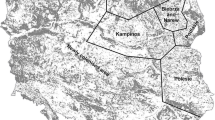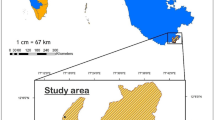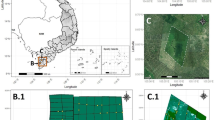Abstract
Chimpanzees make and use a wide variety of tools in the wild. The size and composition of their toolkits vary considerably among populations and at least to some extent within them. Chimpanzees at several well documented sites mostly use tools in extractive foraging, and extractive tool use can substantially increase their foraging efficiency. They also use tools for hygiene and for several other purposes, including attracting the attention of conspecifics, as in leaf-clipping. Some of the interpopulation variation in toolkits results from ecological variation, but differences in the efficiency of social transmission, perhaps related to differences in social tolerance, presumably also contribute. I describe tool use by chimpanzees in an unusually large community at Ngogo, in Kibale National Park, Uganda. Researchers have described some tool use for the community previously, but this is the most extensive report and is based on observations over 11 yr. The Ngogo chimpanzees have a small toolkit and use tools rarely except in leaf-clipping displays and to clean body surfaces; notably, males often use leaf napkins to wipe their penes after copulation. Extractive tool use is rare and is limited mostly to leaf-sponging and, less often, honey-fishing. Social tolerance is not low at Ngogo, but use of tools for extractive foraging, in ways documented at other field sites, may have little potential to increase foraging efficiency. Future research will undoubtedly show more tool use by females, which were underrepresented in my observations, but will probably not document much increase in the toolkit or in the use of extractive tools.
Similar content being viewed by others
References
Beck, B. B. (1980). Animal tool use: The use and manufacture of tools by animals. New York: Garland.
Boesch, C., & Boesch, H. (1984). Possible causes of sex differences in the use of natural hammers by wild chimpanzees. Journal of Human Evolution, 13, 415–440.
Boesch, C., & Boesch, H. (1990). Tool use and tool making in wild chimpanzees. Folia Primatological, 54, 86–99.
Boesch, C., & Boesch-Achermann, H. (2000). The chimpanzees of the Taï forest. Oxford: Oxford University Press.
Boesch, C., & Tomasello, M. (1998). Chimpanzee and human cultures. Current Anthropology, 39, 591–614.
Butynski, T. (1990). Comparative ecology of blue monkeys in high and low density populations. Ecological Monographs, 60, 1–26.
Fox, E. A., Sitampul, A. F., & van Schaik, C. P. (1999). Intelligent tool use in wild Sumatran orangutans. In S. T. Parker, L. Miles, & R. Mitchell (Eds.) The mentality of gorillas and orangutans (pp. 99–116). Cambridge, UK: Cambridge University Press.
Fox, E. A., van Schaik, C. P., Sitampul, A. F., & Wright, D. N. (2004). Intra-and interpopulational differences in orangutan (Pongo pygmaeus) activity and diet: Implications for the invention of tool use. American Journal of Physical Anthropology, 125, 1622–1174.
Fragaszy, D., Isar, P., Visalberghi, E., Ottoni, E. B., & Gomes de Oliveira, M. (2004). Wild capuchin monkeys (Cebus libidinosus) use anvils and stone pounding tools. American Journal of Primatology, 64, 359–366.
Ghiglieri, M. (1984). The chimpanzees of Kibale. New York: Columbia University Press.
Goodall, J. (1986). The chimpanzees of Gombe. Cambridge: Harvard University Press.
Gunther, M., & Boesch, C. (1993). Energetics of nutcracking behavior in wild chimpanzees. In D. Chivers, & H. Preuschoft (Eds.) The evolution of hands (pp. 109–129). Stuttgart: Gustav Fisher Verlag.
Lwanga, J. S., Butynski, T., & Struhsaker, T. T. (2000). Tree population dynamics in Kibale National Park, Uganda, 1975–1998. African Journal of Ecology, 28, 238–247.
McGrew, W. C. (1979). Evolutionary implications of sex differences in chimpanzee predation and tool use. In D. A. Hamburg, & E. A. McKown (Eds.) The great apes (pp. 440–463). Menlo Park: Benjamin/Cummings.
McGrew, W. C. (1992). Chimpanzee material culture: Implications for human evolution. Cambridge, UK: Cambridge University Press.
McGrew, W. C. (1994). Tools compared: The material of culture. In R. W. Wrangham, W. C. McGrew, F. B. M. de Waal, & P. G. Heltne (Eds.) Chimpanzee cultures (pp. 25–40). Cambridge, MA: Harvard University Press.
McGrew, W. C., Ham, R. M., White, L. J. T., Tutin, C. E. G., & Fernandez, M. (1997). Why don’t chimpanzees in Gabon crack nuts? International. Journal of Primatology, 18, 353–374.
McGrew, W. C., Preutz, J. D., & Fulton, S. J. (2005). Chimpanzees use tools to harvest social insects at Fongoli, Senegal. Folia Primatologica, 76, 222–226.
Mitani, J. C., & Watts, D. P. (2001). Why do chimpanzees hunt and share meat? Animal Behavior, 61, 915–924.
O’Hara, S. J., & Lee, P. C. (2006). High frequency of postcoital penins cleaning in Budongo chimpanzees. Folia Primatological, 77, 353–358.
Pepper, J. W., Mitani, J. C., & Watts, D. P. (1999). General gregariousness and specific social preferences among wild chimpanzees. International Journal of Primatology, 20, 613–632.
Reynolds, V. C. (2004). The chimpanzees of the Budongo Forest. Oxford: Oxford University Press.
Sanz, C., Morgan, D., & Gulick, S. (2004). New insights into chimpanzees, tools, and termites from the Congo Basin. American Naturalist, 164, 567–581.
Sherrow, H. S. (2005). Tool use in insect foraging by chimpanzees of Ngogo, Kibale National Park, Uganda. American Journal of Primatology, 65, 377–383.
Struhsaker, T. T. (1997). Ecology of an African rainforest. Gainesville: University Press of Florida.
Sugiyama, Y., & Koman, J. (1979). Tool-using and making behavior in wild chimpanzees at Bossou, Guinea. Primates, 22, 432–444.
van Schaik, C. P., Deaner, R. O., & Merrill, M. Y. (1999). The conditions for tool use in primates: Implications for the evolution of material culture. Journal of Human Evolution, 36, 719–741.
van Schaik, C. P., & Knott, C. D. (2001). Geographic variation in tool use on Neesia fruits in orangutans. American Journal of Physical Anthropology, 114, 331–342.
Watts, D. P. (1998). Coalitionary mate guarding by male chimpanzees at Ngogo, Kibale National Park, Uganda. Behavioral Ecology and Sociobiology, 44, 343–355.
Watts, D. P. (2002). Reciprocity and interchange in the social relationships of wild male chimpanzees. Behavior, 139, 343–370.
Watts, D. P., & Mitani, J. C. (2002). Hunting behavior of chimpanzees at Ngogo, Kibale National Park, Uganda. International Journal of Primatology, 23, 1–29.
Watts, D. P., Lwanaga, J. S., & Potts, K. (2006). Feeding ecology of chimpanzees at Ngogo, Kibale National Park, Uganda. International Journal of Primatology, 27, Supplement 1, 479.
Whiten, A., Goodall, J., McGrew, W. C., Nishida, T., Reynolds, V., Sugiyama, Y., et al. (1999). Culture in chimpanzees. Nature, 399, 682–685.
Whiten, A., Goodall, J., McGrew, W. C., Nishida, T., Reynolds, V., Sugiyama, Y., et al. (2001). Charting cultural variartion in chimpanzees. Behavior, 138, 1481–1516.
Yamakoshi, G. (2001). Ecology of tool use in wild chimpanzees: toward reconstruction of early hominid evolution. In T. Matsuzawa (Ed.) Primate origins of human cognition and behavior (pp. 537–556). Tokyo: Springer-Verlag.
Yamakoshi, G., & Myoma-Yamakoshi, M. (2004). New observations of ant-dipping techniques in wild chimpanzees at Bossou, Guinea. Primates, 45, 25–32.
Acknowledgments
I thank the Uganda Wildlife Authority, The Ugandan Council for Science and Technology, and Makerere University for permission to do research at Ngogo. Gil Isibirye Basuta and John Kasenene provided invaluable support for research efforts at Ngogo. My research on the chimpanzees there depends crucially on the collaboration of Jeremiah Lwanga and John Mitani and the expert field assistance of Adolph Magoba, Godfrey Mbabazi, Lawrence Ndagezi, and Alfred Tumusiime. The L. S. B. Leakey Foundation, The National Geographic Society, Primate Conservation Inc., and Yale University have supported my fieldwork. Earlier versions of the manuscript benefited from the constructive criticism of Ben Beck and 1 anonymous reviewer.
Author information
Authors and Affiliations
Corresponding author
Rights and permissions
About this article
Cite this article
Watts, D.P. Tool Use by Chimpanzees at Ngogo, Kibale National Park, Uganda. Int J Primatol 29, 83–94 (2008). https://doi.org/10.1007/s10764-007-9227-4
Received:
Accepted:
Published:
Issue Date:
DOI: https://doi.org/10.1007/s10764-007-9227-4




